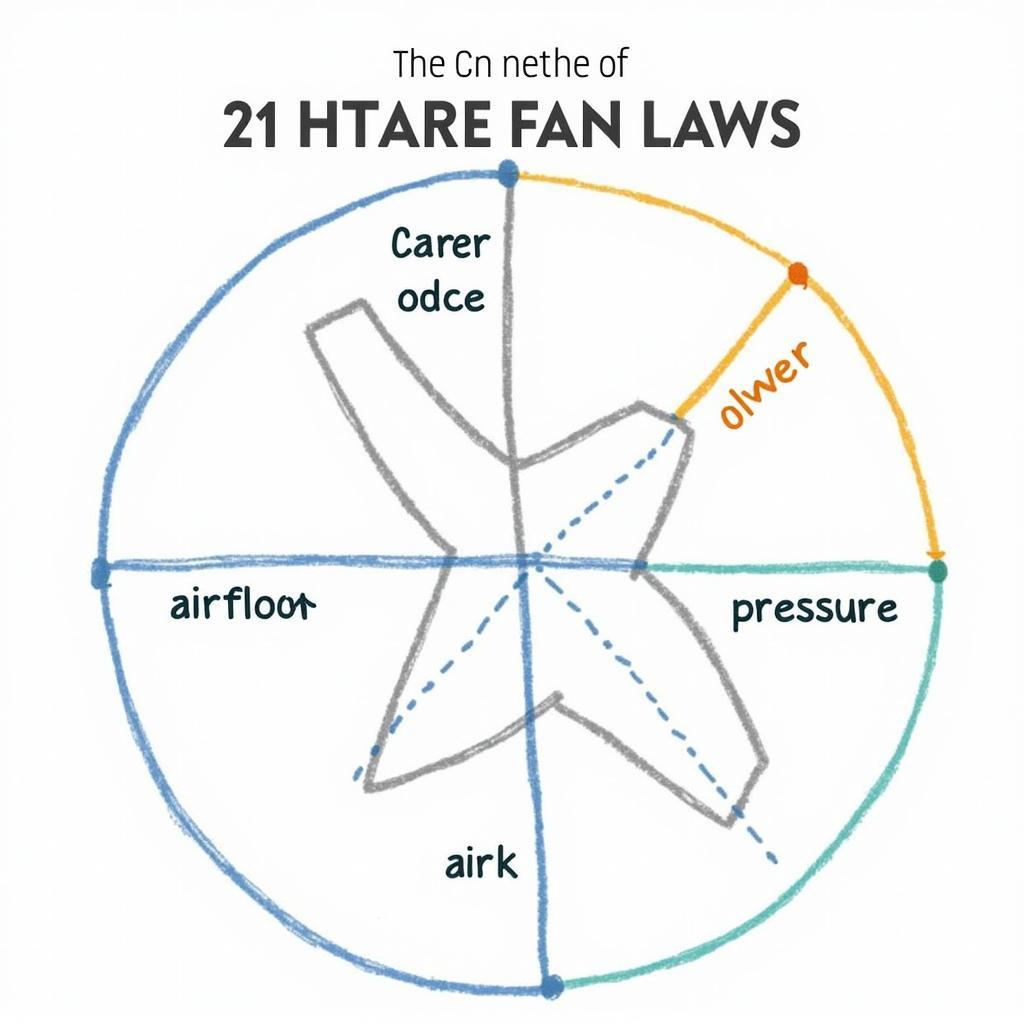Understanding Fan Air Flow Calculation is crucial in various applications, from ensuring optimal cooling in electronics to maintaining a comfortable indoor environment. Whether you’re an engineer designing ventilation systems or a homeowner selecting the right fan, knowing how to calculate air flow is essential.
Factors Influencing Fan Air Flow
Several factors contribute to the amount of air a fan can move.
- Fan Size and Blade Design: Larger fans with steeper blade angles generally move more air.
- Fan Speed: Higher fan speeds result in increased air flow.
- System Resistance: The design and layout of the ductwork or space where the air flows can create resistance, impacting the overall air flow rate.
- Air Density: Air density changes with temperature and altitude. Denser air requires more fan power to move the same volume.
Calculating Fan Air Flow: The Basics
The basic formula for calculating fan air flow (Q) is:
Q = V x A
Where:
- Q is the air flow rate, typically measured in cubic feet per minute (CFM) or cubic meters per hour (m³/h)
- V represents the air velocity, measured in feet per minute (FPM) or meters per second (m/s)
- A is the cross-sectional area of the duct or space where the air flows, measured in square feet (sq ft) or square meters (m²)
 Fan Airflow Calculation Diagram
Fan Airflow Calculation Diagram
Measuring Air Velocity
Accurately measuring air velocity is key to calculating air flow. Several tools can be used:
- Anemometer: This handheld device directly measures air velocity. Different types of anemometers are available, including vane anemometers and hot-wire anemometers.
- Pitot Tube: A pitot tube measures the difference between static pressure and total pressure to determine air velocity. This method is commonly used in industrial settings.
Determining System Resistance
System resistance, also known as pressure drop, can significantly affect air flow. It’s influenced by factors like duct length, diameter, bends, and obstructions. Calculating system resistance often involves complex equations and may require specialized software or the expertise of an HVAC engineer.
Fan Laws: Understanding the Relationship Between Variables
Fan laws are a set of principles that describe the relationship between fan speed, air flow, pressure, and power consumption.
- Fan Law 1: Air flow is directly proportional to fan speed. Doubling the fan speed will double the air flow.
- Fan Law 2: Pressure varies with the square of the fan speed. Doubling the fan speed increases the pressure four times.
- Fan Law 3: Power consumption varies with the cube of the fan speed. Doubling the fan speed increases power consumption eight times.
Understanding these laws helps in predicting how changes in one variable will affect the others.
 Chart Illustrating Fan Laws
Chart Illustrating Fan Laws
Choosing the Right Fan for Your Needs
Selecting the appropriate fan involves considering factors like required air flow, system resistance, noise level, and energy efficiency.
- For residential applications: Look for fans with CFM ratings that meet the room size and ventilation needs.
- For industrial settings: Consult with an HVAC engineer to determine the specific fan type, size, and performance characteristics required.
Common Mistakes to Avoid
- Ignoring System Resistance: Failing to account for system resistance can lead to an undersized fan and inadequate air flow.
- Using Inaccurate Measurements: Incorrect measurements of duct size or air velocity will result in incorrect air flow calculations.
- Overlooking Fan Efficiency: Fans have varying efficiencies. Selecting a high-efficiency fan can save energy in the long run.
Fan Air Flow Calculation: Putting it into Practice
Let’s illustrate with an example. Suppose you need to calculate the air flow of a fan installed in a duct with a cross-sectional area of 2 square feet, and you measure the air velocity to be 500 FPM.
Using the formula Q = V x A, the air flow would be:
Q = 500 FPM x 2 sq ft = 1000 CFM
 Axial Fan in Operation
Axial Fan in Operation
Conclusion
Accurate fan air flow calculation is crucial for optimal ventilation, cooling, and overall system performance. By understanding the factors involved, using the correct formulas, and considering fan laws, you can make informed decisions about fan selection and system design. Remember to consult with HVAC professionals for complex calculations and specialized applications.
FAQs
Q1: What is the difference between CFM and m³/h?
A: CFM (Cubic Feet per Minute) and m³/h (Cubic Meters per Hour) are both units of air flow rate. CFM is commonly used in the US, while m³/h is prevalent in other parts of the world.
Q2: How often should I clean my fan blades?
A: It’s recommended to clean fan blades every 2-3 months to remove dust and debris, which can hinder air flow and reduce fan efficiency.
Q3: Can I adjust the air flow of my fan?
A: Many fans come with speed controls that allow you to adjust the air flow. Some fans may also have adjustable blade angles.
Q4: What is static pressure in fan systems?
A: Static pressure is the resistance to air flow in a duct system. It’s typically measured in inches of water gauge (WG).
Q5: How do I know if my fan is the right size for my application?
A: Consult manufacturer specifications or an HVAC professional to determine the appropriate fan size based on factors like room volume, ventilation requirements, and system resistance.
Need Help with Fan Air Flow Calculation?
For assistance with fan selection, system design, or any ventilation-related inquiries, contact us at:
Phone: 0903426737
Email: fansbongda@gmail.com
Or visit us at: Tổ 9, Khu 6, Phường Giếng Đáy, Thành Phố Hạ Long, Giếng Đáy, Hạ Long, Quảng Ninh, Việt Nam.
Our team of experts is available 24/7 to provide comprehensive solutions for all your fan and ventilation needs. You can also find more information on exhaust fans static pressure calculation pdf and dc motor blower fan on our website. For other topics, such as axial fan in performance, fan bóc máy server, or cpu fan 1 và fan 2, we have dedicated resources available.


